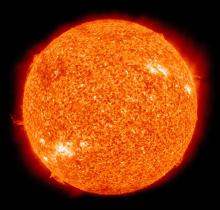Listen to today's episode of StarDate on the web the same day it airs in high-quality streaming audio without any extra ads or announcements. Choose a $8 one-month pass, or listen every day for a year for just $30.
You are here
Caroline’s Cluster
Caroline Herschel spent thousands of nights helping her brother William study the stars. She polished the mirrors for his telescopes, helped operate them, and recorded his observations. And when William was away, she often made her own observations of the sky. Over the years, she discovered eight comets — the big prizes for astronomers of the day. She also discovered 13 objects that are far beyond our own solar system.
The first of those discoveries, made in 1783, is in view on winter nights, in Canis Major, the big dog. You need help to see it, though.
Caroline’s Cluster spans about 15 light-years, and it’s home to several dozen stars. That’s a bit surprising, because the cluster is more than two billion years old. Over that span, most clusters like this one are pulled apart by the gravity of the rest of the galaxy’s stars and gas clouds. The individual stars survive, but they go their own ways. So it’s rare to find clusters of this type that are so old.
To find the cluster — also known as NGC 2360 — first find Sirius, the brightest star in the night sky. It’s in good view in the southeast by 8 o’clock. Caroline’s Cluster is to the lower left of Sirius by less than the width of your fist held at arm’s length. Under dark skies, binoculars reveal a smudge of light with a few individual stars — discovered by one of history’s first female astronomers.
More about the big dog tomorrow.
Script by Damond Benningfield






